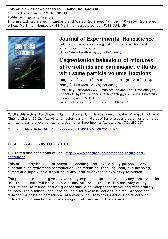摘要
In this study, gamma-Fe2O3 ferrimagnetic nanoparticles and paramagnetic nanoparticles of p-MgFe2O4 (a hydroxide precursor for the preparation of magnesium ferrite materials) are produced by chemical precipitation technology. The gamma-Fe2O3 ferrofluids and p-MgFe2O4 paramagnetic fluids are synthesised by Massart's method. The binary ferrofluids are obtained by mixing the ferrofluids and the paramagnetic fluids. There is insufficient magnetic interaction to aggregate the gamma-Fe2O3 ferrimagnetic system and the p-MgFe2O4 paramagnetic system, so the magnetisation behaviour of the binary ferrofluids can be explored with reference to those of the single fluids. The magnetisation behaviour of single gamma-Fe2O3 ferrofluids may be described by a model of gas-like compression. In the absence of a magnetic field, some particles can self-assemble into aggregates with a closed ring-like structure which make no contribution to the magnetisation of the gamma-Fe2O3 ferrofluids. These ring-like aggregates result in the measured saturation magnetisation of the gamma-Fe2O3 ferrofluids being smaller than the theoretical value calculated from the particles. During the magnetisation process, the polarised p-MgFe2O4 particles gas can orient the rings towards the direction of the field, so that the rings may fragment. Therefore, the measured saturation magnetisation of the gamma-Fe2O3 ferrofluid component of the binary ferrofluids strengthens and the magnetisation process becomes easier than for pure gamma-Fe2O3 ferrofluids.
- 出版日期2012
- 单位西南大学
